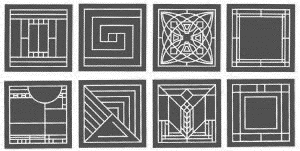              | ||||||
|
||||||
|
|
||||||
|
1. Prepare Look for strong examples of geometric patterns and shadows in your everyday environment as well as in books and websites listed below. Sketch possibilities for your shadow structure, looking at different construction modules. Sketchup Skills - Make sure you are comfortable with navigation, creation tools of Push-Pull, Follow-Me, Selection, Transformations (move, rotate, scale) and the Inference tools & construction lines. 2. Model from an image Try out the tutorial about placing textures, then try generating a geometric panel from an image. Download an image, such as a geometric pattern, and import it your model (File menu > Import > Type of file : JPEG Image. After adjusting the scale of the image, build up 3D forms from the image to create a modular component. Save Views as you work, when you have navigated to a telling perspective, use the View menu > Tourguide > Add Page. Try out Windows > Shadow Settings. 3. Save an image and Post it on a Blog In addition to saving your Sketchup SKP file, save your images with File menu > Export > 2D Graphic > Export Type - JPEG image. Create a Blogger.com account, and try posting a trial image. Send your GTF your new Web address. 4. Develop your model. Use at least one new component that strongly features a repeating pattern to create a beautiful setting for shadow patterns. Feel free to adopt historical motifs into contemporary frameworks as if your job is to include reproductions from the museum collection Move through the model in 3D, adjusting the zoom and pan to find pleasing views. For each view, you can adjust the shadows separately.Sparingly add harmonious color and textures. When in doubt, keep it simple. 5. Create, post and EXPLAIN final images. Save the file in SKP format and save the image in JPG format. Post at least 3 images with ~250 words of explanatory text to your Blogger.com site. Make sure your GTF knows where to find it. FOR THE ADVANCED - Explain your work in relationship to the artwork that inspired it and include a thumbnail image with a link to more information.
REFERENCES Geometry Pattern
in Math & Art by Pippa Drew and Dorothy Wallace, Dartmouth
College Light & ShadowJeremy Birn’s Digital Lighting & Rendering, T385 .B557 2000 http://www.3drender.com/light/ Integrating Images into Sketchup Colors & Materials Self-Paced Tutorial |
||||||
|
|
||||||





